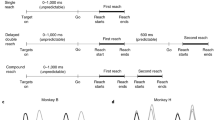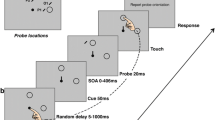Abstract
In this work we have studied what mechanisms might possibly underlie arm trajectory modification when reaching toward visual targets. The double-step target displacement paradigm was used with inter-stimulus intervals (ISIs) in the range of 10–300 ms. For short ISIs, a high percentage of the movements were found to be initially directed in between the first and second target locations (averaged trajectories). The initial direction of motion was found to depend on the target configuration, and on D: the time difference between the presentation of the second stimulus and movement onset. To account for the kinematic features of the averaged trajectories two modification schemes were compared: the superposition scheme and the abort-replan scheme. According to the superposition scheme, the modified trajectories result from the vectorial addition of two elemental motions: one for moving between the initial hand position and an intermediate location, and a second one for moving between that intermediate location and the final target. According to the abort-replan scheme, the initial plan for moving toward the intermediate location is aborted and smoothly replaced by a new plan for moving from the hand position at the time the trajectory is modified to the final target location. In both tested schemes we hypothesized that due to the quick displacement of the stimulus, the internally specified intermediate goal might be influenced by both stimuli and may be different from the location of the first stimulus. It was found that the statistically most successful model in accounting for the measured data is based on the superposition scheme. It is suggested that superposition of simple independent elemental motions might be a general principle for the generation of modified motions, which allows for efficient, parallel planning. For increasing values of D the inferred locations of the intermediate targets were found to gradually shift from the first toward the second target locations along a path that curved toward the initial hand position. These inferred locations show a strong resemblance to the intermediate locations of saccades generated in a similar double-step paradigm. These similarities in the specification of target locations used in the generation of eye and hand movements may serve to simplify visuomotor integration.
Similar content being viewed by others
References
Andersen RA, Essick GK, Siegel RM (1985) Encoding of spatial location by posterior parietal neurons. Science 230: 456–458.
Atkeson CG, Hollerbach JM (1985) Kinematic features of unrestrained vertical arm movements. J. Neurosci. 5: 2318–2330.
Aslin RN, Shea SL (1987) The amplitude and angle of saccades to double-step target displacements. Vision Res 27: 1925–1942.
Barrett NC, Glencross DJ (1988) The double step analysis of rapid manual aiming movements. Q J Exp Psychol 40A: 299–322.
Becker W, Jurgens R (1979) An analysis of the saccadic system by means of double step stimuli. Vision Res 19: 967–983.
Flash T, Henis E (1991) Arm trajectory modification during reaching toward visual targets. J Cogn Neurosci 3: 220–230.
Flash T, Hogan N (1985) The coordination of arm movements: an experimentally confirmed mathematical model. J Neurosci 7: 1688–1703.
Flash T, Henis E, Inzelberg R, Korczyn AD (1992) Timing and sequencing of human arm trajectories: normal and abnormal motor behavior. J Hum Mov Sci 11: 83–100.
Flashner H, Beuter A, Arabyan A (1988) Fitting mathematical functions to joint kinematics during stepping: implications for motor control. Biol Cybern 58: 91–99.
Georgopoulos AP, Schwartz AB, Kettner RE (1986) Neuronal population coding of movement direction. Science 233: 1416–1419.
Georgopoulos AP, Lurito JT, Petrides M, Schwartz AB (1989) Mental rotation of the neuronal population vector. Science 243: 234–236.
Gielen CCAM, Van den Heuvel PJM, Van Gisbergen JAM (1984) Coordination of fast eye and arm movements in a tracking task. Exp Brain Res 56: 154–161.
Hening W, Favila M, Ghez C (1988) Trajectory control in targeted force impulses. V. Gradual specification of response amplitude. Exp Brain Res 71: 116–128.
Henis E (1991) Strategies underlying arm trajectory modification during reaching toward visual targets. PhD Dissertation, Weizmann Institute of Science, Rehovot, Israel.
Henis E, Flash T (1989) Mechanisms subserving arm trajectory modification. Perception 18: 495.
Henis E, Flash T (1991) A mechanism for arm trajectory modification induced by stimuli presented in a quick succession. The 14th Annual Meeting of the European Neuroscience Association, September 7–14, Cambridge, England.
Henis E, Flash T (1992) A computational mechanism to account for averaged modified hand trajectories. In: Moody JE, Hanson SJ, Lipmann RP (eds) Advances in neural information processing systems 4. Part IX. Morgan Kaufmann, San Mateo, pp 619–626.
Henis E, Stanford T, Sparks D (1992) A computational model for modified saccade trajectories. Soc Neurosci Abstr 18: 700.
Hoff B, Arbib MA (1992) A model of the effects of speed, accuracy and perturbation on visually guided reaching. In: Caminiti R (eds) Control of arm movement in space: neurophysiological and computational approaches. Exp Brain Res Suppl 22, Springer-Verlag, Berlin, pp 285–306.
Hollerbach JM, Flash T (1982) Dynamic interactions between limb segments during planar arm movement. Biol Cybern 44: 67–77.
Keele SW (1981) Behavioral analysis of movement. In: Brooks VB (eds) Handbook of Physiology, Sect 1. The nervous system, Vol 2 Motor Control. American Physiological Society, Bethesda, pp 1391–1414.
Marquardt DW (1963) An algorithm for least-squares estimation of non-linear parameters. J SIAM 11: 431–441.
Morasso P (1981) Spatial control of arm movements. Exp Brain Res 42: 223–227.
Morasso P, Mussa-Ivaldi FA (1982) Trajectory formation and handwriting: a computational model. Biol Cybern 45: 131–142.
Munhall K, Lofqvist A (1987) Gestural aggregation in speech. PAW Rev 2: 13–15.
Munoz DP, Pelisson D, Guitton D (1991) Movement of neural activity on the superior colliculus motor map during gaze shifts. Science 251: 1358–1360.
Poulton EC (1981) Human manual control. In: Brooks VB (eds) Handbook of Physiology, Sect 1. The nervous system, Vol 2. Motor control. American Physiological Society, Bethesda, pp 1337–1389.
Rosenbaum DA, Engelbrecht SE, Bushe MM, Loukopoulos LD (1993) Knowledge model for selecting and producing reaching movements. JMotor Behav 25: 217–227.
Soechting JF, Lacquaniti F (1981) Invariant characteristics of a pointing movement in man. J Neurosci 1: 710–720.
Soechting JF, Lacquaniti F (1983) Modification of trajectory of a pointing movement in response to a change in target location. J Neurophysiol 49: 548–564.
Sternberg S, Monsell S, Knoll RL, Wright CE (1978) The latency and duration of rapid movement sequences. In: Stelmach GE (eds) Information processing in motor control and learning. Academic Press, New York, pp 117–152.
Uno Y, Kawato M, Suzuki R (1989) Formation and control of optimal trajectory in human multijoint arm movement. Biol Cybern 61: 89–101.
Van Gisbergen JAM, Van Opstal AJ (1989) Models. In: Wurtz RH, Goldberg ME (eds) The neurobiology of saccadic eye movements. Elsevier, Amsterdam.
Van Gisbergen JAM, Van Opstal AJ, Roebroek JGH (1987) Stimulusinduced midflight modification of saccade trajectories. In: O'Regan JK, Levy-Schoen A (eds) Eye movements: from physiology to cognition. Elsevier, Amsterdam, pp 27–36.
Van Opstal AJ, Van Gisbergen JAM (1990) Role of monkey superior colliculus in saccade averaging. Brain Res 79: 143–149.
Van Sonderen JF (1989) The generation of motor programmes for goal directed movements. PhD Thesis, Utrecht.
Van Sonderen JF, Gielen CCAM, Denier Van der Gon JJ (1989) Motor programmes for goal directed movements are continuously adjusted according to changes in target location. Exp Brain Res 78: 139–146.
Author information
Authors and Affiliations
Additional information
The majority of this work was performed when E.A.H. was with the Department of Applied Mathematics and Computer Science of the Weizmann Institute of Science, Rehovot, Israel.
Rights and permissions
About this article
Cite this article
Henis, E.A., Flash, T. Mechanisms underlying the generation of averaged modified trajectories. Biol. Cybern. 72, 407–419 (1995). https://doi.org/10.1007/BF00201416
Received:
Accepted:
Issue Date:
DOI: https://doi.org/10.1007/BF00201416




